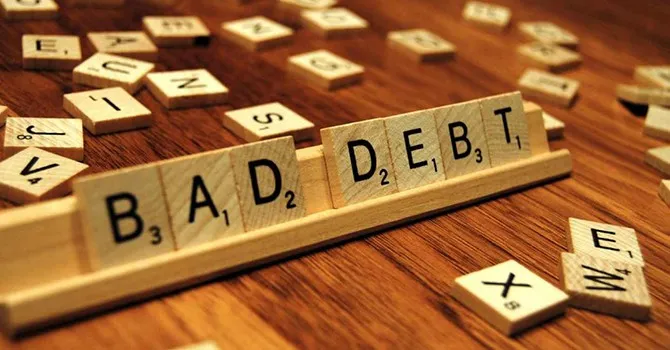
However, the information announced in a press conference relating to the monetary policy in 2021 spoke of the implementation of banking sector tasks in 2022. This indicated that we are overcoming difficulties to support the economy as well as the banking industry during the ongoing pandemic.
Rise in bad debts
Mr. Dao Minh Tu, Deputy Governor of the State Bank of Vietnam, said that credit has recovered well and the banking industry has made many efforts to support the economy as well as businesses. However, despite the goal of maintaining the bad debt ratio below 3%, due to the complicated development of the pandemic, the bad debt ratio on the spreadsheet so far is 1.9%, an increase of about 0.21% compared to 1.69% at the end of 2020. The ratio of bad debt on the balance sheet and debt sold to Vietnam Asset Management Company (VAMC) increased to 3.9%. In a more complete calculation, the forecast for bad debt ratio could be up to 8.2%, or even higher if the pandemic continues to develop and spread virulently.
It can be seen that each time the State Bank of Vietnam publishes data on bad debt, this ratio increases much more. In May 2021, the State Bank of Vietnam forecast that by the end of the year, the bad debt ratio on the balance sheet will be at 1.54% to 1.91%, and the ratio of bad debt on the balance sheet and unresolved debt sold to VAMC, will be 3.43% to 3.84%. Reporting to the National Assembly Economic Committee in September, the State Bank said that it had carefully planned and reported to the Government on the trend of bad debt increasing sharply, with the ratio of bad debt on the balance sheet and potential bad debt at the end of 2021 expected to be 7.1% to 7.7%. However, now the number on bad debts continues to be much higher.
Such a sharp increase in the bad debt ratio is not surprising, because the Covid-19 pandemic has had a strong impact on the activities of most businesses and individuals, especially during the fourth wave. According to Mr. Le Trung Kien, a representative of the State Bank Inspection and Supervision Agency, on an average in 2021, nearly 10,000 businesses withdrew from the market per month, including those that were direct customers of banks. This was one of the sources of bad debts.
Another bad debt that is increasing is the potential source of bad debt from the policy of restructuring the repayment term, with value of accumulated deferral and delay of about VND 607,000 bn. Mr. Nguyen Quoc Hung, General Secretary of the Vietnam Bank Association, said that more than VND 600,000 bn is in the early stages and will increase sharply in 2022 because VND 3,000,000 bn of outstanding loans are affected by the Covid-19 pandemic.
Contributing to the increase in bad debts are loans to risk sectors. The State Bank of Vietnam has always affirmed strict control credit in potentially risky areas, but in fact, these fields still attract credit quite strongly. For instance, in the market report of the third quarter of 2021 for the real estate sector, the Ministry of Construction said that as of 30 September 2021, the credit balance for real estate businesses reached VND 682,594 bn. This figure increased by VND 10,370 bn compared to VND 672,224 bn at the end of June 2021, equivalent to an increase of 1.54%. At the same time, credit for the whole economy only increased by 0.67%, from 6.44% at the end of June to 7.17% at the end of September 2021.
Unseen risk factors
For many years, the State Bank of Vietnam has avoided publishing data related to risk areas and affirmed that it was still under control, although it has failed to create confidence. There is still information showing the inflow of capital to these fields. The opinion of many experts also points out that because the State Bank does not have strict control, apart from the official credit flow, there are many ways for capital from the bank to flow underground into risk areas. When lending to this field, banks receive high-profit margins, but at the same time also create more debt for banks.
Dr. Nguyen Tri Hieu, a financial expert, said that restructuring the repayment term is just like sweeping all the garbage under the rug, by not solving the real problem of the banking system and the economy at present. The State Bank of Vietnam with high bad debt is a challenge for the banking industry in 2022 and following years, but it is necessary to look at it objectively so as to deal with it effectively. As for commercial banks, we draw an insider perspective that bad debt is still not too bad.
Many bank leaders believe that the business plan for 2021 was calculated after drawing lessons from 2020. Moreover, the current trend is that commercial banks have good financial capacity, and the operational safety index is in line with the State Bank practices, while also differentiating risks by increasing service revenue. For rescheduling of debt repayment terms, the State Bank allows three years, but conditional banks still make full provision.
If we look at the analysis of Dr. Le Xuan Nghia, an economist, we see that bad debt is exposed and we need to exercise caution. Since 2016, the banks had been healthy again and financial indicators had been positive. Return in assets (ROA) and return on equity (ROE) were gradually getting better. However, when the pandemic suddenly hit, the market became difficult, and banks dealt rapidly with assets, profits, and equity. Even during the two years of the pandemic, there were banks showing a profit growth rate of nearly 200%. This is unusual and should not be cheered, as it is a most worrisome situation.




















